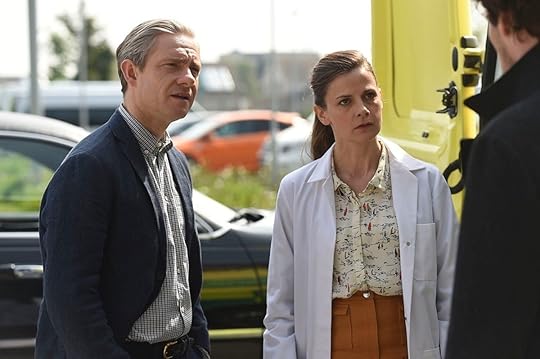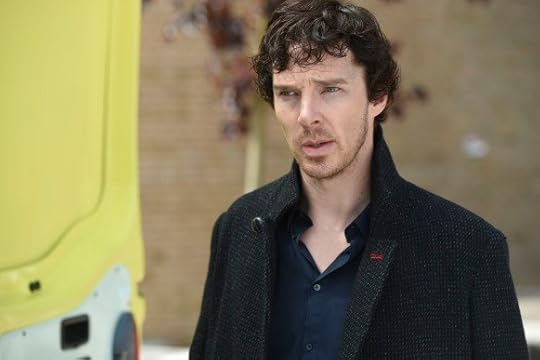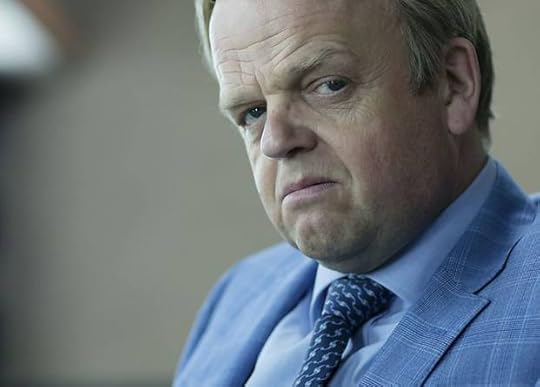Sherlock Review: The Lying Detective
[image error]
(WARNING: THE FOLLOWING REVIEW CONTAINS MAJOR SPOILERS FOR THE LYING DETECTIVE)
Following on last week’s “The Six Thatchers,” I was extremely unsure what to expect. Out of all the options running through my mind, the one initially presented by “The Lying Detective” is one I was hoping to see – an immediate return to the sharp mystery format, with the episode taking on Culverton Smith, as a fairly straightforward (by BBC Sherlock standards) adaptation of Doyle’s “The Dying Detective.”
As with its predecessor, this episode presented excellent performances, but, in my subjective opinion, with a lot more heart in the script. Last week, the principle cast managed, off and on, to pull something compelling out of the episode. This week, the episode itself gave them much more to work with in terms of genuine warmth and expression. I felt like I should care what was happening in “The Six Thatchers” but had trouble getting there. “The Lying Detective,” in contrast, had me in the palm of its hand for more of the narrative. Once again, in a return to past successful formatting, the incisive character revelations went hand-in-hand with Holmes’s steady march toward taking down Culverton Smith through his usual methods of detection.
“The Lying Detective” wasn’t a perfect episode, but it had genuine moments that felt like a partial return to the Sherlock I want to see. Let’s take a look at what worked, what didn’t, and where we’re headed.

Once again, the cast delivered. In particular, Una Stubbs’s Mrs. Hudson brought unexpected humor and expected heart in some of the most joyful moments of the episode. As serial killer Culverton Smith, Toby Jones was deeply charismatic even while he was skin-crawlingly psychopathic. The core cast remained fully committed, and Benedict Cumberbatch and Martin Freeman carried a heavy emotional load in a convincing way. Most unexpectedly, Amanda Abbington gave a touching performance as John’s hallucination of Mary, a conceit that could have come across as ridiculous, but instead acted as an ultimate emotional catalyst for Sherlock and John to reconcile. Abbington didn’t overplay her scenes, and the subtlety was touching. It was also entertaining to see an appearance by Wiggins, who still calls Holmes “Shezza.”
As far as the case itself went, it was a surprising and engaging fusion of Doyle’s “The Dying Detective” and the real-life story of H.H. Holmes, America’s first serial killer, who used his murder castle to terrorize the Chicago World’s Fair. Like Him, Smith had created a hospital that would allow him to gleefully dispatch his victims. As in the Doyle story, Sherlock feigned becoming a victim of Smith and ultimately exposed him as a result, with John’s help. In the story, John is hidden and hears Smith’s confession; in the episode, he provides the cane with a recording device inside it.
In terms of overall positive themes, “The Lying Detective” contains a through-line focused on the value of life. He believes his client is suicidal, and he encourages her not to take her life. Culverton Smith is a villain beyond all others because he takes life without a second thought for the seriousness of his actions. Later in the episode, after seemingly not caring about his own existence, Sherlock says, about Mary Watson, “In saving my life, she put a value on it. It is a currency I do not know how to spend.” By the end of the episode, both he and Watson have accepted the fact that even if life’s loose ends can’t all be tied up, it must be lived fully, with acceptance of what can’t be changed.
Canon references, as always, are ample, most of them from “The Dying Detective” itself, not just in the major plot points, but also down to things like Holmes having papered the flat with pictures of Smith. (In the story, Watson says Holmes has pictures of criminals all over the walls.) “The Veiled Lodger,” with its suicidal client, was also referenced in Holmes’s initial interactions with Faith. His deduction about the note she brought him was also reminiscent of a deduction in “The Boscombe Valley Mystery,” about Watson’s bedroom window. The name “Blessington” referenced a character from “The Resident Patient.” Ultimately, it seems that the final cliffhanger is leading into a “Three Garridebs”-type scenario, in which Holmes shows unusual depth of feeling when Watson is injured (or nearly injured).
As a group, The Babes unanimously felt that the strongest moments of the episode tended to be the simplest–Mrs. Hudson’s quips, Sherlock’s physical deductions of his client, Smith’s final discussion with Sherlock, and the scene in the flat when Watson finally confronts his guilt and grief, and he and Sherlock embrace and reconcile. These “small” moments are tightly-written and emotionally resonant, reminiscent of the best moments of the show’s previous episodes and of the qualities that make Steven Moffat a sometimes-transcendent writer. They gave us hope that the show may be heading back to the essence we love–the crimefighting partnership and unbreakable friendship between Holmes and Watson, complete with self-contained mysteries and sharp, understandable chains of deduction.

Now let’s look at some things that, in our view, didn’t quite make the grade.
First of all, Watson Watson Watson. Following on his text affair last week (which was confirmed this week as being what it seemed), this week we had Watson beating Holmes to a pulp while he was at his worst moment, with Holmes accepting the punishment. It’s hard to construe this as either a good message to send or in-character for the John Watson of the Canon. In Sherlock, Watson has always displayed a violent streak, notably beating Sherlock in “The Empty Hearse,” while Sherlock has always had a penchant for the kind of emotional manipulation that he uses in this episode (acting like he’s about to be killed), seen notoriously during the train scene when he made Watson believe they were both about to die. Their relationship is imperfect at best, but at worst, it gets pushed so far that we’re challenged in our ability to continue to like the characters (Watson, in particular, currently).
Adding to the negative components above is the revelation that the meaning of Mary’s video message was to tell Sherlock to put himself in extreme danger in order to manipulate John to rescue him, supposedly the only way to “help” John. This is obviously meant to produce a parallel of John shooting the cabbie to rescue Sherlock in “A Study in Pink,” which bonded the two men, but as a life message, it’s fraught with problems. Sherlock complies, setting off the Culverton Smith investigation. While the investigation itself is well-executed, having this as a motive is questionable and troubling. It’s just a show, you say. True, but it’s a show that expects us to like, even love, its characters. We’re not supposed to end up thinking they’re all villains, and there’s a difference between being a flawed normal human and being pulled so far that you approach antagonism. We want to love the Holmes and Watson partnership, not feel the weight of massive negative baggage when we see these two together. (Arguably, one of the most charming things about the original stories is the lack of baggage in their relationship.)
Finally, we’re still a bit concerned about the insistence on everything being huge and loud. While, as stated above, this episode featured a welcome return to simplicity off and on, it still presented yet another mysterious Holmes, with a mysterious past and seemingly-impossible skillset. Heaven forbid we get a truly self-contained story that might have been allowed to end on the touching emotional reunion of Holmes and Watson; we had to dial it up to eleven, yet again, and end on a huge cliffhanger with an explosion. Once again, it seems the production team doesn’t realize how much of the audience loves the simple, quiet moments and finds them far more poignant than bombastic quality of the overall arcs.
(Honorable mention of what doesn’t quite work goes to the insertion of Adlock [Irene x Sherlock] and Mycroft having a flirtation with Lady Smallwood. While not huge issues, and not exactly problems on their own, these felt extra to the episode, like random shoehorned-in details that didn’t quite belong.)

Ultimately, we end in a slightly more positive place than last week, appreciative of the golden simple moments this episode brought us and the good, old-fashioned mystery solving. As before, we reserve judgment on the season until it ends, but for now, we hope for a greater appreciation for the less-is-more approach in any future Sherlock episodes, whether this season or in the future. We want to see a detective and doctor, working in tandem and harmony to solve crimes using clever deductions. Please, bring back the Watson we desperately want to see and the partnership that keeps us coming back to the show.
How to purchase my Sherlock Holmes novels:
(Book 1) The Detective and the Woman: A Novel of Sherlock Holmes is available from all good bookstores and e-bookstores worldwide including in the USA Amazon,Barnes and Noble and Classic Specialities – and in all electronic formats including Amazon Kindle , iTunes(iPad/iPhone) and Kobo.
(Book 2) The Detective, The Woman and The Winking Tree: A Novel of Sherlock Holmes is available from all good bookstores and e-bookstores worldwide including in the USA Amazon,Barnes and Noble and Classic Specialities – and in all electronic formats including Amazon Kindle , iTunes(iPad/iPhone) and Kobo.
(Book 3) The Detective The Woman and The Silent Hive is available from all good bookstores including Amazon USA, Amazon UK, Waterstones UK, and for free shipping worldwide from Book Depository. In ebook format it is in Amazon Kindle.
Posted in BBC Sherlock, Uncategorized | Tagged BBC Sherlock, Benedict Cumberbatch, Sherlock, Spoilers, the six thatchers | Leave a reply





